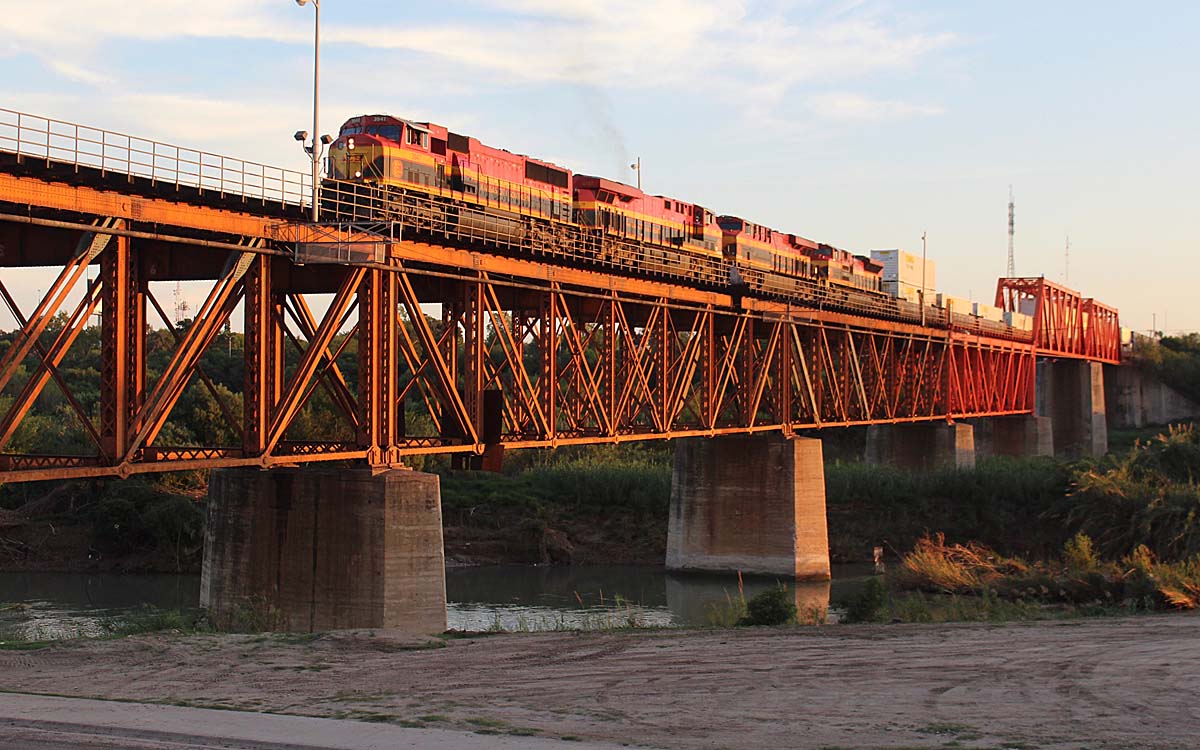
CALGARY, Alberta — Knight-Swift will shift its U.S.-Mexico intermodal traffic from Union Pacific to CPKC’s new single-line route beginning in May.
CPKC and Knight-Swift announced their multi-year agreement today, just four days after Schneider said it would move its U.S.-Mexico intermodal business from UP to CPKC in May under a similar agreement.
“This agreement creates compelling new transportation solutions for Knight-Swift’s current and future customers looking for optionality and increased capacity in their supply chains,” CPKC Chief Marketing Officer John Brooks said in a statement. “As Knight-Swift transitions their Mexico-U.S. traffic to CPKC starting in mid-May, we will focus on growth between Chicago, Texas, and Mexico markets.”
Adam Miller, who serves as chief financial officer for Knight-Swift Transportation and is Swift’s president, said, “Our agreement with the CPKC will provide another differentiated solution for our customers and their over-arching supply chains.”
“The Knight-Swift team is looking forward to engaging with the CPKC railroad on service offerings, customer solution design and demand planning to help facilitate growth on the first single-line railroad connecting Mexico, the United States, and Canada,” Miller added. “Our Transmex team and growing LTL offering will also benefit from the newly created railroad and will allow us to continue supporting our customers in new and different ways by providing thoughtful solutions with a solid underlying service product.”
CPKC’s International Railroad Bridge over the Rio Grande at Laredo offers an alternative to congested highway ports of entry. A second span to expand CPKC’s cross-border capacity is under construction and expected to be completed by the end of 2024.
About 16,000 trucks cross the border at Laredo every day compared to just a few hundred intermodal containers, which CPKC executives have said represents a major growth opportunity.
Despite its longer route, CPKC has said its transit times will be truck-competitive and that it expects to gain nearly 138,000 containers annually that currently move on other railroads in the north-south corridor.
UP, the dominant carrier for traffic moving between the Midwest and Mexico, stood the most to lose from the April 14 merger of Canadian Pacific and Kansas City Southern, which are able to offer single-line service between Chicago and major points in Mexico.
In a pre-emptive strike, UP booted Canadian Pacific from the EMP domestic container pool in October. Canadian National simultaneously became a full partner in the EMP program.
While UP has lost Schneider and Knight-Swift’s Mexico business to CPKC, it stands to gain significant volume from new joint cross-border service that will launch next month with Canadian National and Ferromex. That agreement was announced on Monday.
The Falcon Premium service will connect CN terminals in Canada and Detroit with the Ferromex terminals in Monterrey and Silao via the Eagle Pass, Texas, gateway. CN and UP will use steelwheel interchange to exchange the traffic via CN’s former Elgin, Joliet & Eastern Chicago bypass route.
CN believes there are two trains’ worth of volume moving in each direction every day via truck, based on market research conducted as part of its ill-fated attempt to acquire KCS. If each train carried 250 containers, the service would handle 365,000 boxes per year, with UP serving as the bridge carrier between CN and Ferromex. UP has a 26% stake in the Mexican railroad.






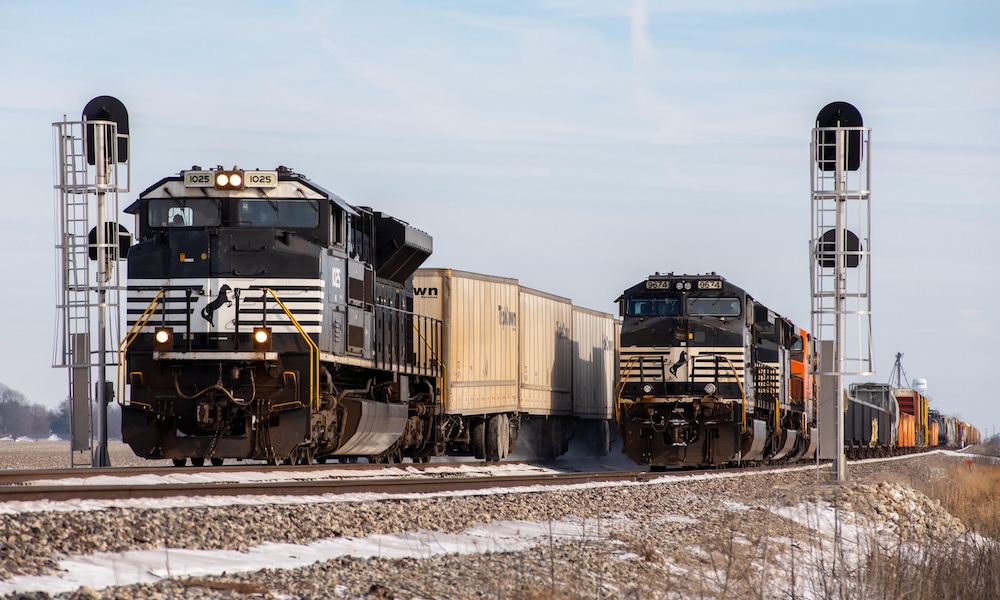
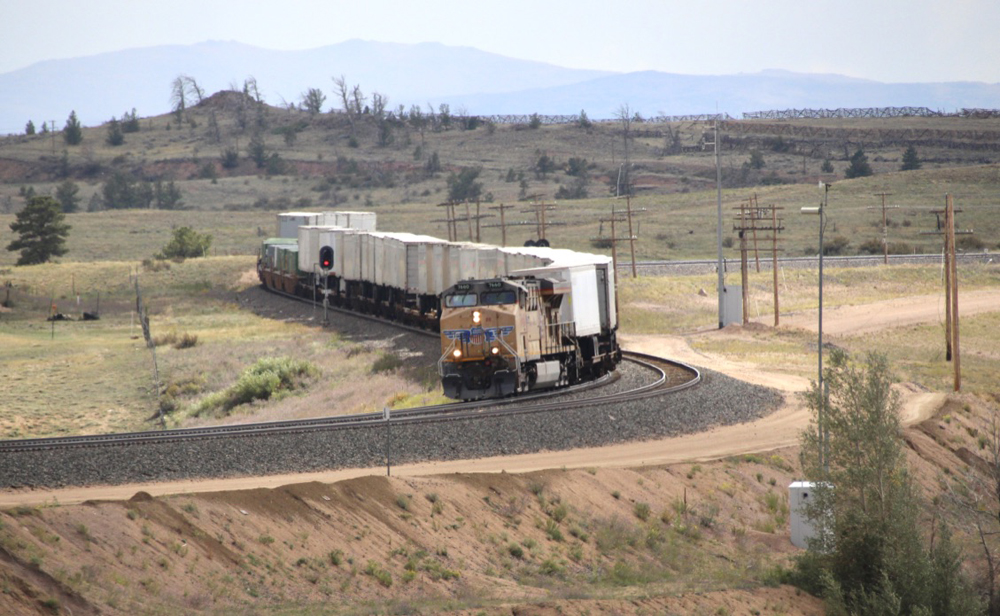
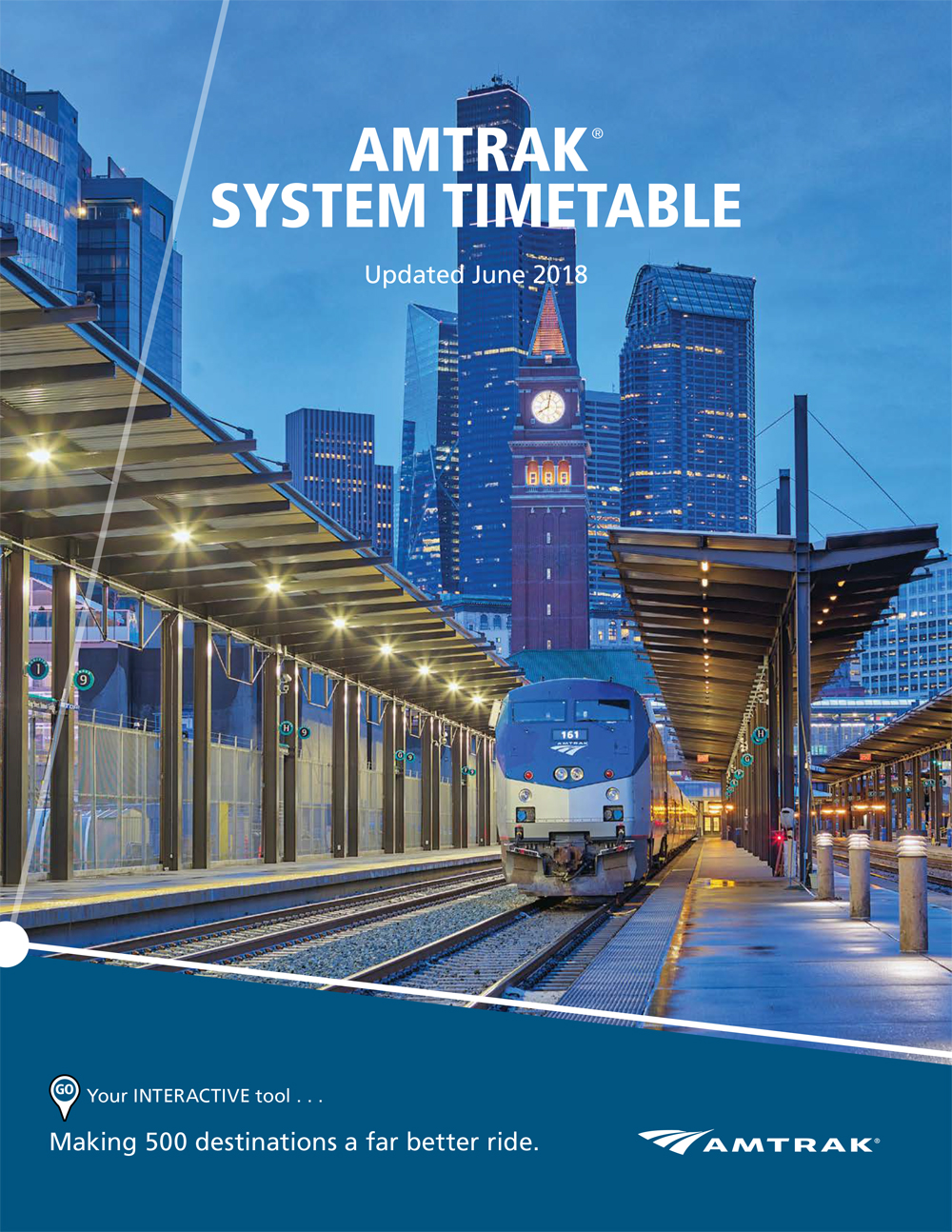
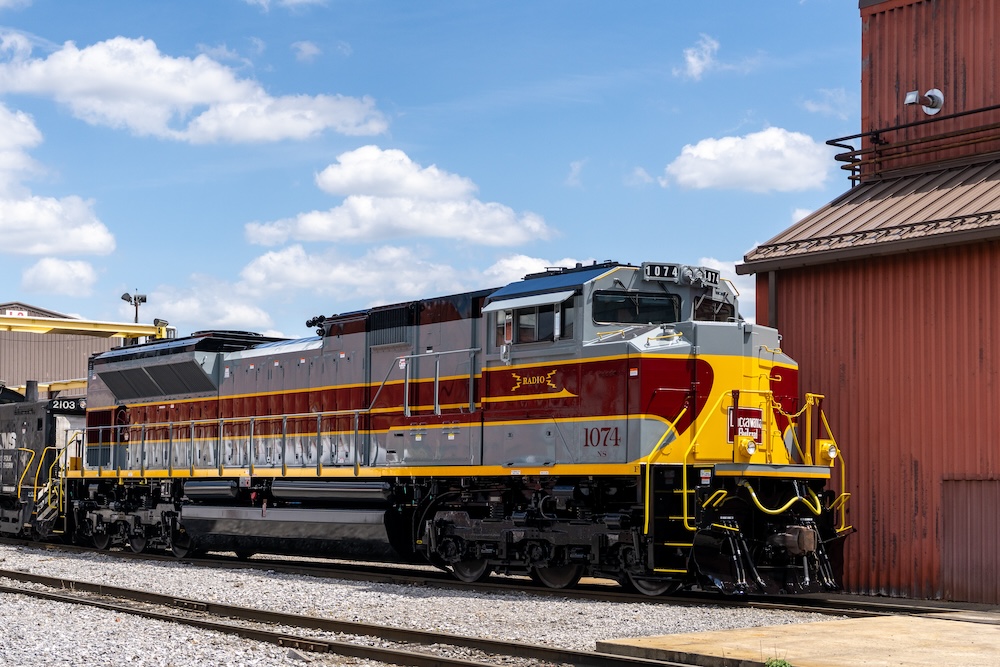




Sure seems funny (not) that both these new intermodal contracts for CPKC were announced right after the CPKC merger was consummated. What an amazing coincidence, indeed. OK, you got the business, but are you going to make any money on it? Did you undercut the competition just to feign immediate “success”?
“Despite its longer route, CPKC has said its transit times will be truck-competitive and that it expects to gain nearly 138,000 containers annually that currently move on other railroads in the north-south corridor.” Really, how? Using a generic Chicago/downtown as a terminus, the UP Laredo-Chicago route via Little Rock and St. Louis is 1,385 miles versus about 1,400 via Interstate Highway. But the CPKC route is nearly 25% longer at 1,721. (Note to CPKC: If you’re best/only route from Laredo to Chicago goes through Louisiana and Kansas, you’re the high-cost route). It’s one thing to have a route 25% longer than the competition, but when it also includes the infamous Houston terminal (where you’re at the mercy of the competition and your testimony to the STB said that your competition didn’t have any capacity constraints there), steeper grades, and routes with limited capacity for additional traffic, it’s easy to see where the actual cost to CPKC would be in the vicinity of 50% greater. Touting the virtues of a single carrier only gets you so far when a bloated cycle time consumes so many more crews, locomotives, fuel, and equipment.
In several years when the CPKC copycat mantra of “Everything Everywhere All At Once” is old news and the operational realities of a vastly inferior route (and only one route, UP and BNSF have multiple) might result in these customers returning to the competition. Or to put it another way: If we could turn back the clock 30 years to 1993 before UP bought SP and BN bought ATSF and CN bought IC and asked the question: Which would be the best routes for traffic from Mexico to get to Chicago, do you think anyone – even if inebriated – would pick the current CPKC?
MARK — How inconvenient be the truth! Your last sentence says it all. If I may, another way of expressing the same question would be this: how much traffic did CP and KC exchange pre-merger? Answer: Not much. Inconvenient truth, KCS as you state is no one’s idea of a wonderful freight corridor. Grafting it onto the end of CP Rail doesn’t change that.
MARK — I also appreciate you second-to-last sentence. Imagine if John Shedd Reed had swallowed his ATSF pride and bought Missouri Pacific which had been offered to him on a silver platter. Imagine those Chicago – Mexico routes!
Could this be a true competitive win-win situation where railroads provide better service and capture truck traffic for a change. I hope so.
Is a significant amount of this intermodal traffic, both UP/CN and CPKC, destined for eastern Canada? If so, it would seem UP/CN trains have the best route through the Chicago metro region via the head-on connection with CN’s former EJ&E at Matteson, some 30 miles south of downtown. I assume CPKC traffic will operate Kansas City to Elgin, across the Metra Milw West (CPKC Elgin Sub) to Cragin, BRC to NS at Rock Island Jct/CP509, and on its trackage rights on the NS Chicago Line to CP358, Butler, IN, and then NS’ former Wabash to Detroit. That’s gonna be some slog at certain periods of the day.
I’ve said it countless times on these pages. I’ll repeat. CP’s route from West Detroit to Kansas City just plain stinks. The CPKC merger shouldn’t have happened without CPKC coming to some sort of agreement with NS for a more direct route, let’s say, the former Wabash main. Going via Chicago/ Elgin not only is much longer but is hopelessly congested.
CPKC starts off with two severe problems: KC to Laredo, and West Detroit to KC.
It seems that CNR got there first with the best routes, CPKC comes into the game to pick up the routes no one else wanted.
The crew change in the middle of the bridge is ridiculous and childish. When will the unions grow up and figure out how to run through at the border. It’s done every day at the Canadian border folks!
IMO think it is more a matter of customs inspections especially drugs. Noticed America crew would leave grips at US customs in the Laredo station before going to the border. Then walking back with just a little paperwork. Reverse when picking up trains from Mexico on the bridge at the border point.
Biden has left the US – Mexico border as open as crossing the street. US Customs is hopeless, per Biden’s policy, to implement any sort of border controls. So Customs picks on the softest target, KCS / KCSM.
Oh Charles, you crack me up!!!
There was a move afoot to have crews run through to the yard on the other side of the border (Sanchez Yard on the Mexico side, Laredo Yard on the US side), eliminating the crew changes on the bridge. However, the unions on the US side would have none of it. Not sure where that effort stands now.
All this new service actual and future anticipated is going to tax the KCS single track route from Houston – TM – Laredo’s international bridge.
The very nature of the Laredo bridge crossing the border with governments just naturally slows trains. The second bridge at Laredo cannot be finished too soon. With the second bridge in service a little coordination will allow trains from each country to meet at the border point on the bridge and exchange crews. There by quickly clearing the bridges for the next train.
The choke point then become the single track sections from bridge North by the east side of the old passenger station then ~12 – 14 miles east to the old TM [ KCS ] ( Texas Mexican RR ) yards. Fortunately all the single track was originally 2 track. No observed encroachment to the removed 2nd track. That line goes thru downtown Laredo with ~ 20 grade crossings. CP may need to restore that 2nd track and probably PTC as there was no signaling on that line the last time there?
South of the bridge ~1500 feet a second main line starts there with small customs shack and goes all the way past the wye connection to a multitrack N-S yard (20?) with turntable.
UP ( MP [ IGN ]) will not have CP’s single track problems. UP branches off the just north of the bridge and it becomes a rather long 6 -8 tracks yard going due north starting just west of the same passenger station.
Mr. Stephens, with all the intermodal action occurring between Mexico and Chicago the last few days, will give you even more to write about in your upcoming special on the changing landscape of western intermodal. Happening faster than you can write. Looking forward to seeing your insight and information. Always enjoy your articles!
CPKC reminds me of the little guy knocking out the big bully on the school playground. UP gobbled up a lot of other smaller railroads in the last 35 years…they’ve nothing to cry about now.
An entirely stupid discussion led by clueless people. Shifting traffic from one rail to another is like re-arranging the deck chairs on the Titanic. To borrow a phrase, “It’s the truckers stupid.”
Mike Haverty understood this when he looked out the window of his business car running along I-40. He saw an endless parade of truckers cruising along and saw the potential.
Aside from the name calling Jim you’re correct..
An entirely stupid discussion led by clueless people. Shifting traffic from one rail to another is like re-arranging the deck chairs on the Titanic. To borrow a phrase, “It’s the truckers stupid.”
Mike Havery understood this when he looked out the window of his business car running along I-40. He saw an endless parade of truckers cruising along and saw the potential.
Both are going to have to place service over OR to win the traffic. Hopefully there is enough traffic for both systems to be profitable.
CN/UP fighting back. In other words, this merger has finally awakened competition despite the naysayers.
The gloves are off.